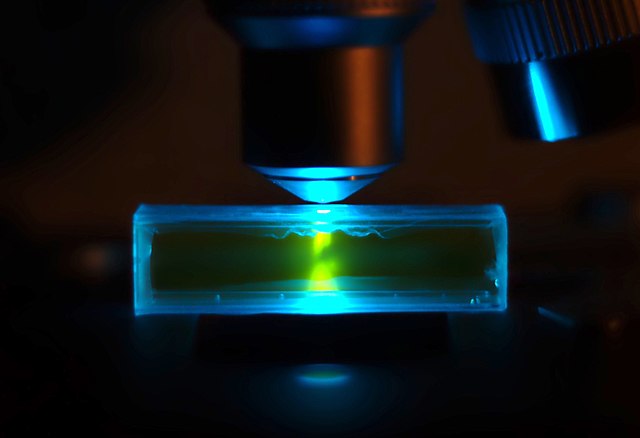Top Qs
Timeline
Chat
Perspective
SYBR Green I
Dye used for molecular genetics From Wikipedia, the free encyclopedia
Remove ads
SYBR Green I (SG) is an asymmetrical cyanine dye[1] used as a nucleic acid stain in molecular biology. The SYBR family of dyes is produced by Molecular Probes Inc., now owned by Thermo Fisher Scientific. SYBR Green I binds to DNA. The resulting DNA-dye-complex best absorbs 497 nanometer blue light (λmax = 497 nm) and emits green light (λmax = 520 nm). The stain preferentially binds to double-stranded DNA, but will stain single-stranded (ss) DNA with lower performance. SYBR Green can also stain RNA with a lower performance than ssDNA.


Remove ads
Uses
Summarize
Perspective
SYBR Green finds usage in several areas of biochemistry and molecular biology. It is used as a dye for the quantification of double stranded DNA in some methods of quantitative PCR.[2] It is also used to visualise DNA in gel electrophoresis. Higher concentrations of SYBR Green can be used to stain agarose gels in order to visualise the DNA present. In addition to labelling pure nucleic acids, SYBR Green can also be used for labelling of DNA within cells for flow cytometry and fluorescence microscopy. In these cases RNase treatment may be required to reduce background from RNA in the cells.
A comprehensive study of Thiazole-Orange-Based DNA Dyes was published, involving SYBR Safe, SYBR Green, PicoGreen, SYTO-16, SYTO-9 and a new derivative TOPhBu. There, the syntheses of these compounds were published and they were characterised spectroscopically to quantify their fluorescence enhancement upon binding to double-stranded DNA. The ability of the dyes to detect DNA at low concentrations was evaluated using two new metrics, absolute fluorescence enhancement (AFE) and relative fluorescence enhancement (RFE). They were tested in qPCR experiments showing some important differences in the sensitivity and qPCR efficiency, which facilitate the DNA marker selection for analytical purposes. [3] The study concluded that Sybr Green exhibits the highest fluorescence enhancement (AFE) and provides the best characteristic for PCR methods. The second best among ther studied dyes was TOPhBu with an analytical performance similar to Sybr Green.
Remove ads
Safety
SYBR Green I is marketed as a replacement for ethidium bromide, a potential human mutagen, as both safer to work with and free from the complex waste disposal issues of ethidium bromide. However any small molecule capable of binding DNA with high affinity is a possible carcinogen, including SYBR Green.
In a study using the Ames test, which measures the ability of chemicals to cause mutations, when assayed at the same concentration SYBR Green I was on the order of 30 times less mutagenic than ethidium bromide.[4]
Remove ads
Similar cyanine dyes
See also
References
Wikiwand - on
Seamless Wikipedia browsing. On steroids.
Remove ads


